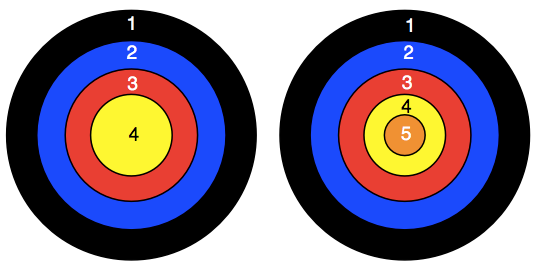Or search by topic
Number and algebra
Geometry and measure
Probability and statistics
Working mathematically
Advanced mathematics
For younger learners
Dart Target



- Problem
- Student Solutions
- Teachers' Resources
Dart Target


An Important Rule:-
You can only have one dart in the same coloured area on any one target, but you could, for example, have a dart in red 3 on the left target and another dart in red 3 on the right target.
CHALLENGE 1
Each time you have a game, you add up the score of the three darts.
Your challenge is to have four games each with the same total score, but made in different ways.
However, note that 1 and 2 on the left target and 3 on the right target is the same as 1 on the left target and 2 and 3 on the right target, so is counted as just one solution.
CHALLENGE 2
Have three games. The three totals must give three consecutive numbers.
In the nine darts used no number must occur more than twice.
So, when Raj chooses:
Game 1: 2 + 3 + 4 = 9
Game 2: 1 + 4 + 5 = 10
Game 3: 1 + 5 + 5 = 11
This is NOT allowed as three 5s have been used and the maximum is two.
CHALLENGE 3
You now move on to having three targets with four darts for each game.
As before you can only have one dart in any coloured sector of a target.
The targets are:
1, 2, 3
1, 2, 3, 4
1, 2, 3, 4, 5.
Firstly see how many different totals you can make.
Finally find all the ways of getting the set of three consecutive 11, 12, 13
But in a set of three answers you must not use the same number more than three times.
So, when Sara chooses:
Game 1 1 + 2 + 3 + 5 = 11
Game 2 1 + 2 + 4 + 5 = 12
Game 3 2 + 2 + 4 + 5 = 13
This is not allowed as four 2s have been used and the maximum is three.
Find as many answers as you can.
Why do this problem?
This activity was designed for the 2016 National Young Mathematicians' Award (NYMA) so it might be a particularly useful activity for a small group of your highest-attaining pupils to work on. (For more information about the NYMA, see this brief article which is part of this feature.) This task is a useful vehicle for developing systematic approaches. It can be used as an activity to encourage children to explain in written or spoken words what it is they have done.
Possible approach
Since this activity is aimed at the most confident mathematicians, there will not be much that you have to do to introduce it apart, perhaps, from showing big examples of the two original targets and the associated scoring. You may find this double-sided sheet of the challenge useful for printing and giving out to learners: Word
document or pdf
Key questions
Tell me about how you are getting a solution for the challenge you are working on.
(When encouraging the pupils as they work on the task, try to avoid saying things about what you notice and directing them in your way of attempting a solution.)
Possible extension
Learners might like to try the other two challenges that were part of the National Young Mathematicians' Award 2016: Open Squares and Painting Possibilities.
You may also like
Prompt Cards
These two group activities use mathematical reasoning - one is numerical, one geometric.
Consecutive Numbers
An investigation involving adding and subtracting sets of consecutive numbers. Lots to find out, lots to explore.
Exploring Wild & Wonderful Number Patterns
EWWNP means Exploring Wild and Wonderful Number Patterns Created by Yourself! Investigate what happens if we create number patterns using some simple rules.

